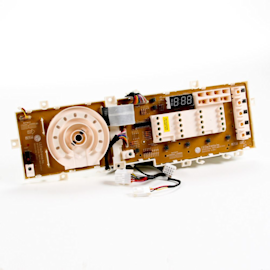- Kenmore refrigerator water filters
- Whirlpool refrigerator water filters
- Samsung refrigerator water filters
- GE refrigerator water filters
- LG refrigerator water filters
- Frigidaire refrigerator water filters
- KitchenAid refrigerator water filters
- Maytag refrigerator water filters
- Kenmore Elite refrigerator water filters
- Estate refrigerator water filters
- GE Profile refrigerator water filters
- Amana refrigerator water filters
- Bosch refrigerator water filters
- Dacor refrigerator water filters
- Electrolux refrigerator water filters
How to clean and maintain your washing machine


Your washing machine is a workhorse that handles a huge chunk of the household chores. Do without your washer for a week and you’ll clearly understand how valuable it is.
With all of the filling, sloshing, draining and spinning it does, your washing machine deserves some cleaning and maintenance attention every year. Otherwise, it can easily give up on doings the heavy laundry work that you’re expecting it to do.
Keep your washer clean and well maintained to get your laundry done load after load.
How to clean your washer
Use a washer cleaner such as Affresh or Washer Magic to clean the inside of your washing machine.
Washer cleaners remove residue and odor that build up in front-load and top-load washing machines. Use a washer cleaner monthly to keep your machine clean and your clothes smelling fresh.
How to clean the door boot on a front-load washer
The rubber door boot on a front-load washer often holds water and builds up mold and mildew that begin to smell if you don’t clean it. Follow these steps to clean the door boot:
Empty all garments from the washer.
Mix 3/4 cup of liquid chlorine bleach with 1 gallon of warm water.
Put on protective gloves.
Wipe the rubber door boot with the bleach solution. Be sure to wipe behind the door boot and inside all folds.
Let the bleach solution stay on the door boot for 5 minutes to help eliminate all mold and mildew.
Rinse the area thoroughly with plain water.
Run an empty cycle in the washer with no detergent added to rinse out bleach residue.
Open the door wide and let the seal air dry.
Repeat this procedure monthly to keep the door boot clean and smelling fresh.
If possible, leave the washer door open to keep air circulating through that area so mold has no chance of forming in between cleanings.
Clean the end of the washer drain hose
Pull the drain hose out of the stand pipe or drain sink and check for residue in the hose opening. Clear any lint or debris clogging the hose. Reinstall the hose in the stand pipe or drain sink.
Check the fill hoses
Fill hoses can wear out and crack over time. A leaky fill hose can cause a flood and/or water damage in your laundry room.
Check your washer fill hose for cracks or wear and replace them if they’re old or worn. Don’t risk a flood or water damage by ignoring potential fill hose problems.
Clean the washing machine cabinet
Wipe down the washer cabinet with a moist cloth to remove dirt and residue. Use mild detergent if necessary to remove stubborn stains. Rinse the cabinet thoroughly using a cloth moistened with plain water if you used detergent for cleaning.
Have your washer professionally maintained yearly by Sears
To keep your washing machine in top condition and avoid unexpected breakdowns, schedule professional Cleaning & Maintenance service every year.
During washer service, the technician will:
Inspect water fill hoses. The technician will inspect fill hoses for cracks and wear that can indicate potential failure. The tech will recommend fill hose replacement when it’s likely that a fill hose is at the end of its useful life. This maintenance step is often the most important one that the technician performs.
Check the washer tub and internal hoses for wear and leaks. Some internal washer leaks begin as small drips you may not even notice. Small leaks can eventually turn into large ones that damage walls and flooring. During washer maintenance, the technician will check internal fill hoses, dispenser hoses and drain hoses for leaks and wear that need addressing.
Test the washer drain system. The washer won’t clean and spin clothes if the drain system doesn’t fully remove water during the drain portion of the cycle. The technician will check drain pump operation and the complete drain path through your home’s drain system. The tech can clear obstructions and let you know if your house drain needs clearing.
Check water fill level and water temperature. To keep your washer working efficiently and avoid garment damage, the technician check water fill levels and the water temperature. The washing machine won’t clean the clothes well if water level is too low. Too much water can cause leaks and damage suspension components. Water also needs to be at the right temperature to clean clothes properly. When water temperature isn’t hot enough, detergent won’t dissolve and clothes won’t get clean. You might even see detergent residue can on clothes when water temperature is too low. Water that’s too hot can shrink delicate garments and damage certain fabrics. Hot water also can cause bright colors to fade or run.
Check the suspension system and spin cycle operation. Excessive vibration or banging during the spin will often result in clothes being too wet when the cycle ends. While banging during the spin cycle can be caused by an unbalanced load, it can also be caused by tub suspension problems. The technician will test the spin cycle and make sure that suspension components such as shock absorbers and springs are intact and working properly. The tech also will check washer leveling and stability and adjust leveling legs as needed to minimize vibration during the spin cycle.
Run a cleaning cycle. The technician will typically run a cleaning cycle using a washer cleaner to remove deposits and detergent residue from the washer.
Bundle appliance maintenance to save money and keep all of your home appliances in top shape. A Sears tech can clean and maintain your dryer, refrigerator, dishwasher and stove at the same time as your washer.
You can trust Sears to help you keep all your home appliances working more efficiently and lasting longer.
Symptoms for front-load washers
Main causes: leaky water supply hoses, clogged drain system, torn door boot, cracked outer tub, overfilling…
Main causes: bad door lock assembly, wiring failure, bad electronic control board, drain system failure, bad water-level…
Main causes: garments left in the washer, damaged spin basket, worn outer tub bearing, faulty drive motor, bad electroni…
Repair guides for front-load washers

How to replace the door boot on a front-load washer
If your washer leaks from under the door panel, replace the rubber door boot if it's torn.…
Repair difficulty
Time required
60 minutes or less

How to replace the user interface board in a front-load washer
Follow these steps to replace the user interface board in your front-load washer if the buttons or lights are broken.…
Repair difficulty
Time required
30 minutes or less

How to replace the drain pump on a front-load washer
Follow these steps to replace the drain pump if it's not removing water from the washer.…
Repair difficulty
Time required
45 minutes or less
Articles and videos for front-load washers

Find tips for using your washing machine efficiently to save energy and help reduce utility bills.…

Learn about all the convenient features on our Sears PartsDirect website that make your parts purchases easier.…

See how to access and clean the drain pump filter on a front-load washer without an access door.…